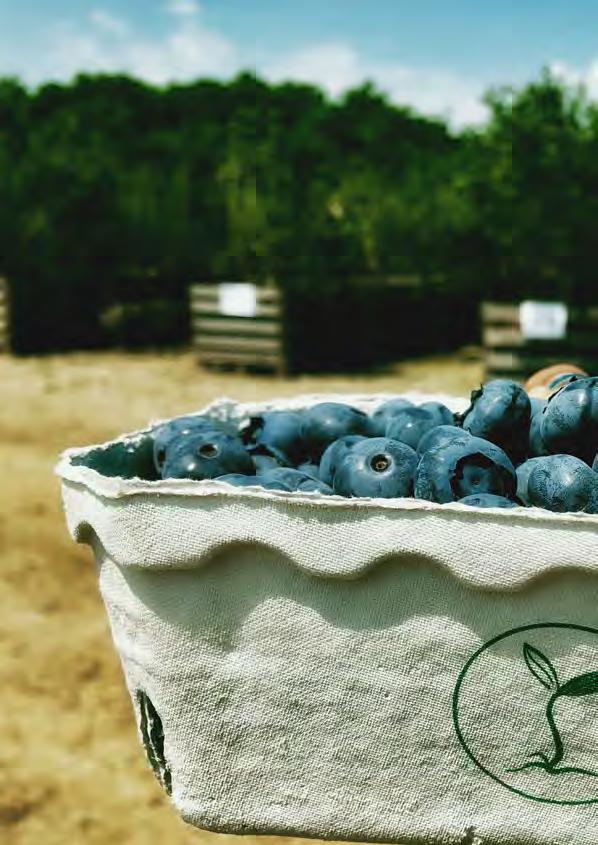
3 minute read
SUSTAINABLE DEVELOPMENT
As farmers, we have an important role to play in solving some of the world’s global challenges. We are aligned with the 10 universal principles on environment, human rights, labour and anti-corruption. We also support the UN Sustainable Development Goals. We have identified six SDGs that apply to our farming operations, and where we have the greatest potential for impact. These are aligned with our internal goals.
Ensure sustainable food production and implement resilient agricultural practices that increase productivity, that strengthen capacity for adaptation to climate change, and that progressively improve land and soil quality.
Improve water quality by reducing pollution, eliminating dumping and minimising release of hazardous chemicals and materials.
Increase water-use efficiency and ensure sustainable withdrawals and supply of freshwater to address water scarcity.
Protect and restore waterrelated ecosystems, including mountains, forests, wetlands, rivers, aquifers and lakes.
INCREASE IN YIELDS
We want to increase our crop production efficiency and have a goal to improve our yields by 1% per year.
WATER HABITATS
Because waterbodies enhance biodiversity, we want to have water habitats on 1% of our land.
Achieve productive employment and decent work for all women and men, and equal pay for work of equal value.
Protect labour rights and promote safe working environments for all workers.
TRAINING
Training is important to keep our teams updated and motivated. Our goal is that 2% of yearly working hours is spent on training.
BUILDING TOPSOIL
Our goal is to grow the topsoil layer by 2 mm per year. The deeper the topsoil, the larger an area for the plant roots to find water and nutrients, and the stronger the crop.
WATER USE
We want to produce more crop per drop, and our goal is to improve our water use efficiency by 2% per year.
BUFFER STRIPS
We create non-cultivated and unsprayed buffer zones 10-metres along all major streams, rivers to diminish nutrient leaching and pesticide run-off into the water.
GENDER DIVERSITY
We are equal opportunity employers. Our goal is for the underrepresented gender to reach at least 40%. Women are currently the underrepresented gender.
ENERGY USE
We want to improve our energy use efficiency by 2% per year. While supporting financial results, this will also benefit the environment and climate.
GRASS WATERWAYS
We grow natural, native grass waterways in low parts of fields, where water runs during wet conditions. This helps reduce the water velocity and the risk of erosion.
EROSION-PRONE SLOPES
We keep erosion prone slopes under permanent grass/ plantings to avoid erosion. We either leave these areas to natural regeneration or plant them in native species.
SYNTHETIC PESTICIDEFREE
We have decided to phase out the use of synthetic pesticides on our farms and become synthetic pesticide-free by 2030.
CONTOUR CULTIVATION
To avoid erosion, we never cultivate fields straight up and down the hills. Instead we cultivate along the contours.
Achieve the sustainable management and efficient use of natural resources.
Reduce food losses along production and supply chains, including post-harvest losses.
Achieve environmentally sound management of chemicals and significantly reduce their release to air, water and soil to minimise their adverse impacts on human health and the environment.
Substantially reduce waste generation through prevention, reduction, recycling and reuse.
Strengthen resilience and adaptive capacity to climaterelated hazards and natural disasters in all countries
Ensure the conservation, restoration and sustainable use of terrestrial and inland freshwater ecosystems.
Implement a sustainable management of all types of forests, halt deforestation, and restore degraded forests.
Reduce the degradation of natural habitats, halt the loss of biodiversity and, protect and prevent the extinction of threatened species.
Prevent the introduction and significantly reduce the impact of invasive species.
INSECT/BEE PLANTS
We grow a mix of plants that blossom at different times of the season to provide pollen and nectar forage for bees and other insects.
SCRUFFY LOOK
We avoid designing landscapes with manicured lawns and plantings in neat patterns. Instead we leave areas for natural regeneration. Also, we leave standing and lying dead wood, as they are important habitats.
CREATING HABITATS
Our goal is to convert 10% of each farm's area to natural habitats. We also avoid cultivating small field triangles and convert obsolete or low yielding areas into habitats.










